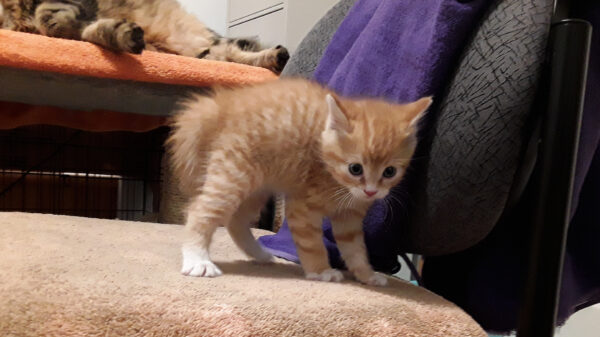Cat Integration

Cats are social and territorial therefore, introductions require a little finesse, a lot of patience, and rewards, such as toys and treats. Even though a new cat introduction to your home and residents may take some work on your part, it’s a small amount of time given what the long-term reward will be; cats who learn to co-exist peacefully and, in many cases, form close relationships.
Use our animal care tips to prepare for your new arrival ahead of time. Whether you are adding a second cat to your household or your seventh cat, there is no introduction shortcut. Approach introductions with care from the start.

When you bring a cat into a new home, it is absolutely necessary that they have their own safe sanctuary room with their own litter box. The sanctuary room can be a bathroom or a bedroom, or another suitable enclosed space. Even if your cat won’t have any other pets to deal with, a sanctuary room is still needed. The newcomer needs a quiet, safe area where she can adjust to her new home.
The sanctuary room gives the newcomer an opportunity to get familiar with the scents of her new home. It also gives her time to get to know you and begin the trust-building process. For a rescued cat that has been through a physical or emotional trauma, a sanctuary room enables her to make the transition in calm, comforting way. A sanctuary room provides a safe place for your new cat to retreat and rest.
A sanctuary room can be any room in your home that has a door. Your cat does not need a lot of space right now; she needs safety and security. It can be overwhelming for a cat to try to get comfortable and find her way around a new home. She may not remember the location of the litter box in time to take care of business or where she last saw her food. Unfamiliar surroundings, sounds and smells can be especially overwhelming and unfair to a kitten, who will need a convenient set up since her litter box habits are still in the learning stage. If you are bringing an adult cat home, you will need to consider the stress factor as well. Instead of your new cat spending the first couple of months hiding behind furniture or under the bed, set up a sanctuary room with her food and litter box so she can begin to get used to her new home and begin exploring on her terms.

The room should not be empty – cats need safe places to hide. It’s important to set up additional places so the cat doesn’t just dive under the bed if you’re using a bedroom and stay put for weeks. Boxes are simple and effective hiding places. Put one or two on their sides and line them with towels or T-shirts that contain your scent. If the cat is truly terrified, use the boxes, or paper bags, to make tunnels for her. Make sure the size of the box and the holes you cut match the size of the cat. Soft-sided fabric tunnels also work.
Place the food and water bowls on one side of the room and the litter box on the opposite wall. The litter box should not be located close to the food because cats do not like eliminating where they eat. No matter how small the sanctuary, make sure you’ve separated the food from the litter box as much as possible.
The litter box should be uncovered. If you are bringing home an adult cat who had a previous home, try to use the same type of litter she is accustomed to and then gradually transition to the kind of litter you use with the rest of your cats mixing in a small amount of the new litter into the current brand, slowly increasing the amount over the course of several days.

Cats are agile, quick and curious – which means that you can count on them to get into every corner of your home as well as your heart. It is vital that you cat-proof your home, starting with the sanctuary room. Cats are amazing jumpers and can leap up onto surfaces several feet high. Throughout your home, it is important to anchor unsteady or top heavy furniture and decor to the wall – things like bookshelves, computer monitors, top heavy lamps, or plant stands. Secure dangling electrical cords, phone chargers, and such with zip ties or tape. Make sure windows are secure – cats are amazing at squeezing through cracks and nudging into small spaces. Toss or give away plants that are toxic and/or poisonous to cats, and replace them with safe alternatives. Close or even lock kitchen and bathroom cabinets, and while you are at it, ensure that household cleaners are out of reach (in a cupboard or inaccessible shelf). Keep washer & dryer doors hut, toilet seats down, and cover up receptacles that cats might fall into, including garbage cans. Plug a night-light into the Sanctuary so you won’t have to flick on a bright light when you enter the room to check on your cat. This will be especially important if you’re dealing with a rescued cat or one who is very frightened in the new surroundings. Do your own research into the helpful information online about cat-proofing your home to keep your newest family member safe.

If the newcomer is an adult, use Feliway in the room. This is a behaviour modification product that contains synthetic feline facial pheromones. Cats rub their faces where they feel comfortable, and the scent helps them feel reassured and calm. Feliway comes in a plug-in diffuser and a spray bottle. The spray bottle requires you to spray every twelve hours. For ease of use, you can plug in a diffuser in the Sanctuary room – it lasts about a month and covers approximately 650 square feet.

The sanctuary will need a scratching post. This is not only important so the cat can condition her claws and stretch her muscles, but it’s comforting for a newcomer entering unfamiliar territory to be able to see her claw marks and recognize the scent left by the pheromones in her paw pads. If you’re adopting a kitten, it’s also important to have a scratching post in the sanctuary room so she can get a head start on appropriate training.
If possible, don’t use one of the scratching posts currently in your home in the sanctuary room. Your newcomer doesn’t need to be overwhelmed by the markings and smells of the other cats right off the bat. Also, you want to cause minimal disruption to your resident cats, so moving one of their posts would not be a good idea.
There are horizontal pads such as inexpensive corrugated cardboard scratchers that cats love, as well as the vertical carpet covered ones. Since you probably won’t know whether the newcomer has a preference for the horizontal or vertical scratching or both, you’ll be covering your bases and protecting your furniture if you can provide both.

Cats are natural hunters and like to stalk, chase, pounce on, and capture things that move. Most cats enjoy a variety of toys that they can hunt, seek, attack, and carry. A variety of toys can maintain interest; keep several toys on hand, and rotate a few different toys each week to keep your cat’s interest. It is a good idea to provide toys for your cat to enjoy during solo object play and get or make at least one interactive fishing pole toy for interacting with your cat. The interactive toy will be an important tool for building trust so you can keep your distance while the cat learns to associate you with positive experiences. Do not leave cats unattended with fishing pole toys as they can get tangled in the toy or ingest the string and become seriously ill. For solo toys you might try a couple of furry toy mice, several types of soft and light balls they can bat around, and small stuffed toys. Some toys come filled with catnip; estimates suggest that half of all cats love catnip, while the other half ignore it or become adverse. Choose appropriate toys for the cat’s age, size, and temperament. Avoid huge, intimidating toys for a kitten or a frightened cat. Do your own research online for ideas of cat toys you can buy or make. Observe how your cat will make common objects into toys, and be sure to remove those that are unsafe.

Cats love and need elevated perches, so add a window perch or a cat tree to the room if you can. At the very least, put a cat bed on top of a box or piece of furniture or lay a couple of extra pillows or folded towels on the bed

Let’s start with litter boxes. If you have more than one cat, you may need to increase the number of litter boxes in your home. Even if you’re going from just one cat to two, that doesn’t mean they will share a box. If you have several cats, adding another kitty may throw off the litter box balance, so keep an eye on things and be ready to increase the number of litter boxes as you have cats or at least as close to that as possible. The addition of a new cat is also a good time to install a cat tree or window perch, especially if you are going from one cat to two.

The big day has finally arrived. Bring the cat (in her carrier) into the home and go right to the sanctuary room, which you will have already set up. If the cat is an adult, open the carrier and then leave the room. This way, she can stay in the carrier until she feels comfortable enough to start investigating the room and will not be intimidated by your presence. Have food and water set up for her, although she probably won’t be interested in it right away. She may, however, appreciate that the litter box is so conveniently located. It’s good the leave the newcomer alone for a while so you can concentrate on your resident kitties, which may or may not be aware of what just took place. If the newcomer is a kitten, you may want to spend a little time with her before leaving the room to make sure she knows where everything is located.
When you leave the room, don’t overcompensate for the new situation by cuddling excessively or your cats will be convinced that something big is up. Be as casual and as normal as possible. If one or two of your cats hang out by the sanctuary door and appear upset, you can conduct an interactive play sessions right there and then gradually entice the cat away from the door. You can’t keep the cats away from the door (and actually, you do want them to start investigating), but by doing play sessions, you may be able to keep a kitty from camping out at the door and getting very upset.
Interactive playtime with the newcomer is an important trust-building exercise to start immediately. If the newcomer is a kitten, the playtime will help her bond with you and also help her work off some of that endless kitten energy. If the newcomer is an adult, especially if she’s frightened, the interaction will help her stay within her comfort zone while playing. This is a great way to build trust.
Once the newcomer is in the sanctuary room, you may need to leave things at this stage for a while before progressing. Your cats may already be upset over the fact that someone’s on the other side of the door. You need to let them get used to this and give the newcomer time to get situated. Use your best judgement concerning the time to start actively introducing the kitties. You know your cats better than anyone else, so you should be able to tell when it’s okay to proceed. For example, your cats should be on their usual routine (for the most part), willing to play, and not redirecting aggression toward companion cats. The newcomer must be secure and comfortable as well before beginning or else she’ll just spend all of her time hiding. There is no set time for how long introductions should take. Every cat is an individual, and every owner’s set of circumstances are different. Some cats can breeze through this process in a matter of days, and others take weeks or even months. Don’t be discouraged if your introduction takes longer than the one of your neighbours did for their cats. Let the cats set the pace.

The first sense to introduce is scent. This sock exchange activity can help the newcomer and residents to begin the get to know one another in a very safe, controlled way. Pheromones are scent chemicals that tell a lot about a cat to others. This way of sharing of information of the friendly facial pheromones is a great first ‘how do you do’.
Take a few pairs of socks and put one sock on your hand. Now rub one of your resident cats gently along the cheek to collect some facial pheromones. Use a different sock for each cat so you don’t cause tension. If you have a large cat community, don’t rub everyone at the same time. Start with one or two you feel will be more receptive to the new cat. Choose a sociable but calm cat to prevent intimidating the newcomer. This will come in handy later because you’ll be introducing those cats first.
Once you’ve collected the scent on one sock, go into the sanctuary room and, with a clean sock, rub the newcomer around the face if she’s comfortable enough to allow it. Leave the resident’s sock in the newcomer’s room and take the newcomer’s sock into the main part of your home. If the newcomer is frightened or you feel rubbing her cheeks will damage any trust building you’ve already done, then don’t worry about it. You can just place a couple of clean socks in one of her beds and, after she has been lying on them, take those out to the main part of the house for the resident cats. Don’t use anything bigger than a sock. You don’t want to overwhelm anyone with something as big as a scented towel.
The sock exchange can also help you determine how upset or calm a particular cat may be. If the cat hisses, growls or attacks the sock, chances are any introductions will take additional patience, time and care. If the cat sniffs the sock and shows only mild interest, that is a good sign. Even if the cat does not show a strong negative reaction to the shock, don’t be discouraged. Introductions take time and care in the beginning, but that’s not necessary an indication of how the cats will ultimately get along. Do the sock exchange several times a day until you feel everyone has become somewhat familiar with one another’s scents.

To begin, put the resident cats in a separate area of the home so the newcomer can safely start to become familiar with a larger territory without fear of being ambushed. As she moves around the house she’ll also deposit more of her scent, which will help your resident cats adjust to her ever-increasing presence.
When you let the newcomer out of the sanctuary room for the exchange, just open the door and let her walk out on her own so she’ll know the sanctuary room is right behind her if it’s all moving too fast. Don’t pick her up and drop her in the middle of the living room because she’ll probably be frightened and will just end up hiding. If she starts to look nervous, you can use an interactive toy to entice her. If she’s food motivated, offer a treat as she ventures out.
It’s now time for your resident cats to check out the newcomer’s territory. Obviously you’ll have to make sure the newcomer is safely in another room. Depending on how many cats you have and their personalities, you should start with the one or two kitties most likely to accept the newcomer. One thing to watch for when doing a room switch is redirected aggression. If one of the resident cats gets too upset, she may lash out at a companion cat, which is why it’s important to be careful about which cats you let into the sanctuary room initially. It may be better to do it one at a time. Also, don’t just dump a resident cat into the sanctuary room; rather, open the door and let her decide how far and fast she wants to go.
If you live in a small apartment and there aren’t enough rooms to do this, you may wish to enlist the help of a family member so you don’t have to play cowboy to a heard of cats. If you live alone, ask a cat-loving friend or neighbour to help. You can put the newcomer in her carrier and have the neighbour take her out of the apartment temporarily while the kitties check out the sanctuary room.
After the room exchange, reward your cats with a meal or a treat. Always end these training sessions on a positive note. Keep the session short. What’s most important is the newcomer’s discovery of the main part of the home. It isn’t as crucial that the resident cats explore the sanctuary, so if they get upset, discontinue the activity and wait for another day.
Try the room exchange a couple of times a day until you feel that the cats are comfortable or at least getting comfortable with one another’s scents. It might take just one day to it might take several. Again, patience is key and let your cats set the pace.

Okay, now that everyone is getting comfortable with new scents, it’s time to let the cats see one another. Their exposure should be brief, positive, and at a safe distance. Remember one of the rules mentioned earlier: You must give the cats a reason to like each other. Open the sanctuary room door and let the cats see one another while everyone is offered a treat or a meal. Make sure to offer the newcomer and residents their treats on opposite sides of the room. When using cat treats, break them into small pieces so you don’t interfere with regular nutrition. The cats will still view it as an extra-special treat. If your cats don’t like the commercial treats, you can use small pieces of shredded cooked chicken.
If they’re really food motivated, you can feed their meals in the presence of one another. Place the bowls on one side of the room. You want to show the cats that good things happen when they’re in one another’s company. If some of the cats aren’t food motivated, you can use toys as a form of diversion. If one cat gets too focused on another, you can shift her attention to the toy. It’s okay if the newcomer chooses to stay at the far end of the sanctuary room. End the session immediately after everyone has had a snack or a few minutes of playtime. It’s better to do several thirty-second sessions that end positively than to force the cats together for half an hour and end the session unexpectedly with hissing or growling. It may be tempting to keep a session going longer because the cats seem to be getting along, but remember there will be time for that later. It’s worth taking the extra time now to set the kitties up with the best chance of being friends. In the beginning, use short, positive sessions and then safe retreat.
Periodically, take the tiniest amount of soiled litter from the newcomer’s litter box (use no more than on eighth teaspoon to start) and place it in one of the litter boxes that the resident cats use. Don’t use more to start with or you’ll risk creating a litter box aversion problem. Then take a tiny amount of soiled litter from one of the main litter boxes (again, no more than one-eighth teaspoon) and place it in the newcomer’s box. If the cats show a negative reaction, back off and next time use an even smaller amount.

When cats interact for longer periods of time (an hour or more), keep the sanctuary set up because you’ll want to put the newcomer back in there at night and when you’re not around to supervise. As for supervision, keep it casual in appearance so the cats don’t feel as if you’re hovering over them. You want to see their reactions, and they may not act as naturally if you’re too close. Some cats feel more secure when the owner is nearby, so you’ll have to create a balance: present but casual and relaxed.
If you sense too much focus on the newcomer or growing tension, toss out some treats or a toy to divert them. Anything that will be viewed as positive to shift their mind-set will work. Keep an interactive toy nearby to use if you notice one cat starting to stalk another, and try to use it before an actual incident occurs. In a pinch, if one cat is about to attack another, you can make a loud noise or clap your hands, but the more you can keep things positive, the faster the cats will accept one another. Don’t get upset and never punish any of your resident cats for showing aggression. This will only undo the positive associations you’re trying to establish.
Watch for subtle threats. A direct stare and raised hindquarters is an easy posture for owners to miss but is most intimidating to a new cat. You may want to put bells on the collars of the cats that consistently display aggression so everyone can better monitor their whereabouts.
Whether the introduction takes days, week, or months, don’t get discouraged. It is best to let the cats set the pace.

Introductions can take a few weeks or a few months, and depending on their history, temperament, some cats may take a long time to become accustomed to their new home. Sometimes a newcomer may be hesitant to leave the safety of the sanctuary room. If that’s the case, try slowing down the introduction. One option is to put a screen door on the sanctuary room in place of the regular door. If you want to leave the regular door up, get three baby gates and put them in the doorway – one on top of another. Get the hinged-kind that swing open so that you won’t have to take the gates down every time you want to enter or exit the room. The screen door or the baby gates will allow the cats to see one another. This method isn’t needed in most cases; however, taking this middle step can help hesitant cats make progress before transitioning to unrestricted access.
